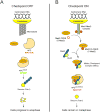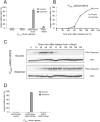Mad2 and Mad3 cooperate to arrest budding yeast in mitosis
- PMID: 22209528
- PMCID: PMC3277655
- DOI: 10.1016/j.cub.2011.12.029
Mad2 and Mad3 cooperate to arrest budding yeast in mitosis
Abstract
Background: The spindle checkpoint ensures accurate chromosome transmission by delaying chromosome segregation until all chromosomes are correctly aligned on the mitotic spindle. The checkpoint is activated by kinetochores that are not attached to microtubules or are attached but not under tension and arrests cells at metaphase by inhibiting the anaphase-promoting complex (APC) and its coactivator Cdc20. Despite numerous studies, we still do not understand how the checkpoint proteins coordinate with each other to inhibit APC(Cdc20) activity.
Results: To ask how the checkpoint components induce metaphase arrest, we constructed fusions of checkpoint proteins and expressed them in the budding yeast Saccharomyces cerevisiae to mimic possible protein interactions during checkpoint activation. We found that expression of a Mad2-Mad3 protein fusion or noncovalently linked Mad2 and Mad3, but not the overexpression of the two separate proteins, induces metaphase arrest that is independent of functional kinetochores or other checkpoint proteins. We further showed that artificially tethering Mad2 to Cdc20 also arrests cells in metaphase independently of other checkpoint components.
Conclusion: Our results suggest that Mad3 is required for the stable binding of Mad2 to Cdc20 in vivo, which is sufficient to inhibit APC activity and is the most downstream event in spindle checkpoint activation.
Copyright © 2012 Elsevier Ltd. All rights reserved.
Figures






Comment in
-
Mitosis: short-circuiting spindle checkpoint signaling.Curr Biol. 2012 Feb 21;22(4):R128-30. doi: 10.1016/j.cub.2012.01.018. Curr Biol. 2012. PMID: 22361149
Similar articles
-
Two complexes of spindle checkpoint proteins containing Cdc20 and Mad2 assemble during mitosis independently of the kinetochore in Saccharomyces cerevisiae.Eukaryot Cell. 2005 May;4(5):867-78. doi: 10.1128/EC.4.5.867-878.2005. Eukaryot Cell. 2005. PMID: 15879521 Free PMC article.
-
The spindle checkpoint functions of Mad3 and Mad2 depend on a Mad3 KEN box-mediated interaction with Cdc20-anaphase-promoting complex (APC/C).J Biol Chem. 2008 Aug 22;283(34):23039-47. doi: 10.1074/jbc.M803594200. Epub 2008 Jun 13. J Biol Chem. 2008. PMID: 18556659 Free PMC article.
-
Budding yeast Cdc20: a target of the spindle checkpoint.Science. 1998 Feb 13;279(5353):1041-4. doi: 10.1126/science.279.5353.1041. Science. 1998. PMID: 9461437
-
Regulation of APC-Cdc20 by the spindle checkpoint.Curr Opin Cell Biol. 2002 Dec;14(6):706-14. doi: 10.1016/s0955-0674(02)00382-4. Curr Opin Cell Biol. 2002. PMID: 12473343 Review.
-
Dual inhibition of Cdc20 by the spindle checkpoint.J Biomed Sci. 2007 Jul;14(4):475-9. doi: 10.1007/s11373-007-9157-3. Epub 2007 Mar 17. J Biomed Sci. 2007. PMID: 17370142 Review.
Cited by
-
Distinct requirements for the COMPASS core subunits Set1, Swd1, and Swd3 during meiosis in the budding yeast Saccharomyces cerevisiae.G3 (Bethesda). 2021 Oct 19;11(11):jkab283. doi: 10.1093/g3journal/jkab283. G3 (Bethesda). 2021. PMID: 34849786 Free PMC article.
-
Bimodal activation of BubR1 by Bub3 sustains mitotic checkpoint signaling.Proc Natl Acad Sci U S A. 2014 Oct 7;111(40):E4185-93. doi: 10.1073/pnas.1416277111. Epub 2014 Sep 22. Proc Natl Acad Sci U S A. 2014. PMID: 25246557 Free PMC article.
-
The C-terminal domains of human neurofibromin and its budding yeast homologs Ira1 and Ira2 regulate the metaphase to anaphase transition.Cell Cycle. 2014;13(17):2780-9. doi: 10.4161/15384101.2015.945870. Cell Cycle. 2014. PMID: 25486365 Free PMC article.
-
The mitotic checkpoint complex binds a second CDC20 to inhibit active APC/C.Nature. 2015 Jan 29;517(7536):631-4. doi: 10.1038/nature13911. Epub 2014 Nov 12. Nature. 2015. PMID: 25383541 Free PMC article.
-
The composition, functions, and regulation of the budding yeast kinetochore.Genetics. 2013 Aug;194(4):817-46. doi: 10.1534/genetics.112.145276. Genetics. 2013. PMID: 23908374 Free PMC article. Review.
References
-
- Li R, Murray AW. Feedback control of mitosis in budding yeast. Cell. 1991;66:519–531. - PubMed
-
- Hoyt MA, Totis L, Roberts BT. S. cerevisiae genes required for cell cycle arrest in response to loss of microtubule function. Cell. 1991;66:507–517. - PubMed
-
- Li X, Nicklas RB. Mitotic forces control a cell-cycle checkpoint. Nature. 1995;373:630–632. - PubMed
-
- Stern BM, Murray AW. Lack of tension at kinetochores activates the spindle checkpoint in budding yeast. Curr Biol. 2001;11:1462–1467. - PubMed
Publication types
MeSH terms
Substances
Grants and funding
LinkOut - more resources
Full Text Sources
Other Literature Sources
Molecular Biology Databases

